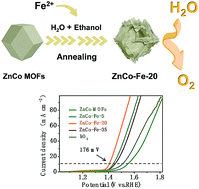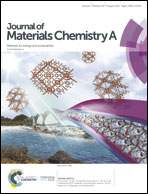MOFs-derived ZnCo–Fe core–shell nanocages with remarkable oxygen evolution reaction performance†
Abstract
Various renewable energy systems, such as water splitting cells and metal–air batteries, are based on the oxygen evolution reaction (OER). The replacement of common noble-metal platinum catalysts with highly efficient, cheap, and operationally stable electrocatalysts opens huge potential applications for OER; thus, there have been increasing efforts to develop alternative efficient OER catalysts via low-cost fabrication processes. Herein, we report a facile self-templated method to synthesize ZnCo–Fe core–shell nanocages derived from metal–organic frameworks (MOFs) as an efficient catalyst for OER. The unique structure of ZnCo–Fe core–shell nanocages offers a large active surface area with abundant active sites and efficient charge transfer capability as the hollow structure facilitates the active direct contact of materials with electrolytes. We introduced these catalysts at different ratios of Fe, which had a significant effect on the electrocatalytic performance of OER. In other words, the introduction of Fe not only changed the composition but also changed the morphology to expose numerous active sites for OER. Owing to the synergistic effect between the element composition and abundant active sites, the optimized ZnCo–Fe-20 sample presented a superior electrocatalytic OER performance with a very low overpotential (η = 176 mV at 10 mA cm−2) and a small Tafel slope (69.3 mV dec−1). This developed strategy can be easily extended to synthesize other MOF-derived polymetallic oxide-based hybrid electrodes for OER as a practical route for the design of cheap and efficient electrocatalysts.



 Please wait while we load your content...
Please wait while we load your content...